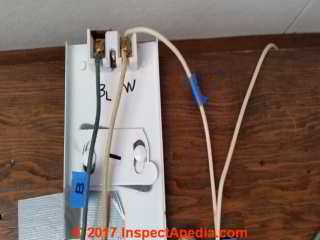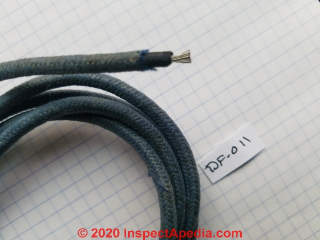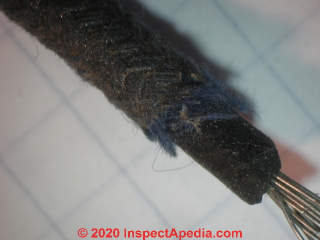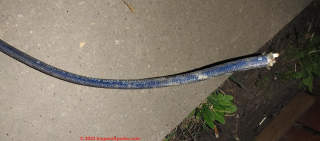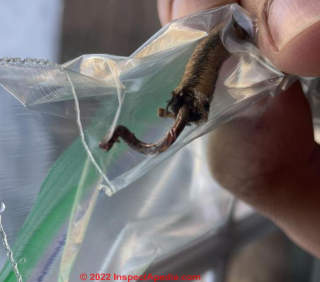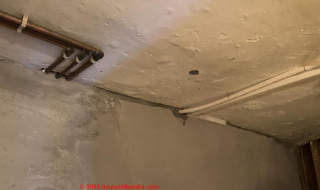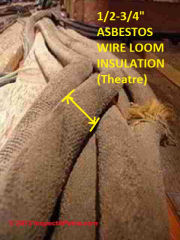 Asbestos Electrical Wire Insulation & Asbestos Electrical Insulation Products What sorts of electrical wire are likely to have used asbestos insulation?
Asbestos Electrical Wire Insulation & Asbestos Electrical Insulation Products What sorts of electrical wire are likely to have used asbestos insulation?
- POST a QUESTION or COMMENT about what building materials may contain asbestos, visual identification of asbestos-containing materials in buildings, and possible asbestos material identification by testing, use, age, appearance
Asbestos insulation history, manufacture, visual identification includes asbestos used in electrical wiring and appliances.
Here we describe how to recognize asbestos-based or asbestos containing electrical insulation materials in products & buildings - a visual guide to identifying asbestos in buildings.
Asbestos electrical insulation was in common use in North America between about 1920 and 1988. Page top photograph: asbestos insulation on electrical wiring in a theater.
This articles series about the manufacture & use of asbestos-containing products includes detailed information on the production methods, asbestos content, and the identity and use of asbestos-containing materials. Page top photo shows asbestos used in an electrical motor.
InspectAPedia tolerates no conflicts of interest. We have no relationship with advertisers, products, or services discussed at this website.
- Daniel Friedman, Publisher/Editor/Author - See WHO ARE WE?
Asbestos Electrical Insulation Materials History & Manufacturing Processes
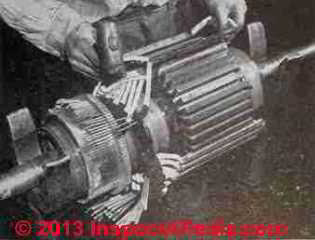 The following text is Adapted from Rosato (1959) p. 106-112 [1] © 2020 InspectApedia.com
The following text is Adapted from Rosato (1959) p. 106-112 [1] © 2020 InspectApedia.com
One of the major uses for asbestos paper as well as for such forms of asbestos as yarn, tape, lap, and loose fiber is in the field of electrical insulation. Asbestos was used in both higher voltage AC or DC electrical wiring as well as in low voltage wiring products such as telephone cabling.
[Click to enlarge any image]
The main reasons for the use of asbestos are its fire and heat resistance, electrical insulation properties, acid resistance, and durability.
Electrical insulation is also used to protect the surfaces of conductors from such adverse conditions as moisture and chemicals, and to fill spaces where corona discharge is liable to occur.
In electrical applications, asbestos insulation is used with low iron content. All grades of crude and milled chrysotile fiber are predominately used.
The lowest iron content fibers
for use in the electrical field are available from ore deposits
in the North American Continent. ASTM specifications list
the total iron content for electrical grade products. Details are
List of products using asbestos electrical insulation
Large quantities of asbestos are used to cover electrical wire in the traction type of electric motors and coils where there is a possibility of rising temperature damaging ordinary cotton coverings.
The general use of asbestos electrical insulation includes ordnance equipment (aircraft, missiles, etc.) oil burners, heating and cooking apparatus, lighting equipment, agricultural machinery, construction and mining machinery, hoists, oil field machinery, machine tools, portable tools, bakery machinery, food products 'machinery, textile machinery, paper industry equipment, pumps and 106 compressors, conveying equipment, blowers and fans, trucks and tractors, industrial ovens and furnaces, mechanical stokers, computers and cash registers, vending machines, laundry equipment, vacuum cleaners and units, refrigeration and air conditioning units, motors and generators, power transformers, switchgear controls, welding units, insulated wire and cable, lamps, radio, TV and radar units, x-ray units, railroad units, dental units, and signs and advertising displays.
Lightweight asbestos insulation is of primary importance on Naval and Maritime ships. Navy cable insulation is of particular importance; it is a combination of asbestos paper and textile products (lap, tape, etc.)
In the manufacture of multi-conductor cables, the single or paired conductors are cabled into required multiples, together with cushioning fillers in the valleys. These fillers are generally made with asbestos roving.
Specifications for Asbestos-Based Electrical Insulation Materials
Classification of electrical insulation by the American Institute of Electrical Engineers (AIEE) follows:
Classes of Electrical Insulation Materials |
||
| Organic, not impregnated | 195 | |
| Organic, impregnated | 220 | |
| Inorganic, organic binder | 265 | |
| Inorganic, silicone binder | 355 | |
| Completely inorganic | 355+ | |
Notes to the table above
Watch out: This data is circa 1959 from AIEE and is not current; therefore the table is provided for historic reasons and not as a current standard for electrical insulation products.
Another classification which includes asbestos-electrical insulated products is given by the Underwriter's Laboratories, Inc. This laboratory classifies asbestos electrical insulating material as asbestos-insulated wire (460 12) and as asbestos-varnished cloth wire (460 13).
Asbestos-Insulated Wire (460 12) Labels & Classifications
- Type A, with asbestos insulation
- Type AA, with an asbestos braid and asbestos insulation
- Type Al, with impregnated asbestos insulation
- Type AlA, with asbestos braid and impregnated asbestos insulation
Asbestos-Varnished Cloth Wire (460 13)
- Type AVA, An asbestos braid: an insulation consisting of varnished cloth and impregnated asbestos.
- Type AVB, A plain [flame?] -retardant cotton braid: an insulation consisting of varnished cloth and impregnated asbestos.
- Type ABL, A lead covering: an insulation consisting of varnished cloth and impregnated asbestos.
Watch out: by visual inspection I don't think we can distinguish cloth, non-asbestos wiring insulation of this age from Type AVB, A plain [flame?] -retardant cotton braid: an insulation consisting of varnished cloth and impregnated asbestos. The wire shown above is discussed
at OLD ELECTRICAL WIRING TYPES
Data pertaining to electric shipboard cable which includes asbestos is given in the "Cable Comparison Guide," NAV- SHIPS 250-660-23 (1956) published by Bureau of Ships, Navy Department, Washington 25, D. C. and available through Government Printing Office.The data pertains to Government procurement specifications MIL-C-915A (Ships), MIL-C-2194B (Navy), MIL-C-2681 (Ships), and MIL-W-16878B (Navy). All cables are identified by types.
The letters listed under types identify the first letters of the words used in describing the cable. Other letters identify construction of the cable. Some of these cables which incorporate asbestos are identified as follows:
- DFPA, Double conductor, flame proof, armored: Natural rubber of asbestos-varnished cambric-asbestos insulation depending on size, cabled with fillers, belt, armored.
- DHFA, Double conductor, heat and flame resistant, armored: Size 3, 4 and 9 with synthetic resin and felted asbestos insulation; sizes 14 and larger with asbestos-varnished cambric-asbestos insulation, cabled with fillers, belt, impervious sheath, armored.
- DHFTA, Double conductor, heat and flame resistant, thin wall, armored: Thin wall synthetic and felted asbestos insulation, cabled with fillers, binder, impervious sheath, armored.
- FHFTA, Four conductor, heat and flame resistant, thin wall, armored: Thin wall synthetic and felted asbestos, insulation, cabled with fillers, binder, impervious sheath, armored.
- MFPP, Multiple conductor, flame proof, plain: Asbestos varnished cambric insulation, cabled with fillers, binder, textile braid overall.
- SFPA, Single conductor, flame proof, armored: Asbestos varnished cambric-asbestos insulation, textile braid, armored.
- TFPA, Three conductor, flame proof, armored: Asbestos varnished cambric-asbestos insulation, cabled with fillers, belt, armored.
Also see OLD ELECTRICAL WIRING TYPES where we illustrate non-asbestos varnished-cloth insulation on copper electrical wires.
Asbestos Paper Products as Electrical Insulation
Asbestos papers are very popular for use in the manufacture of miniature electrical component units. Miniature transformers can use asbestos papers. A 30 per cent reduction in weight has been obtained in Class-B transformers.
I [DF] have also found asbestos-paper insulated electrical wire inside of some older electrical appliances such as stove tops and toasters though more often we found braided asbestos cloth insulated wire in those locations.
World War II initiated many development projects specifically for developing inorganic paper products.
Prior to 1940, no inorganic papers were commercially available. At present, there are four basically different types of inorganic papers commercially available; i.e., asbestos, mica, glass, and ceramic.
Asbestos papers are manufactured by Johns- Manville, Inc. under the trade name "Quinterra" or "Quinorgo"; by Raybestos-Manhattan, Inc. under the trade name "Novabestos"; and by General Electric Co. under the trade name "Terratex."
These basic paper products are available in many different forms which include combinations of asbestos-glass, asbestos-mica, papers backed with or sandwiched between other types of papers or fabrics and held together by an oleoresinous varnish, shellac, silicone, rubber, or other composite insulation structures. These combinations provide for increased tensile strength which is desirable in many of the cable or wire taping operations.
The chief function of asbestos [in electrical applications] is that of a separator or as a wrapping for wire insulation. Untreated paper is roughly equivalent to air as an insulator; when it is completely dry its resistivity is good.
Untreated paper can contain moisture since it has the characteristic of absorbing moisture from the air—a characteristic typical of other paper products. It is usually treated with a varnish or lacquer in order to eliminate the moisture problem.
Where high temperature requirements are of prime interest, the paper is treated with silicone varnishes or fluorocarbons.
In the manufacture of asbestos paper, there is always continued interest and development in producing open asbestos fibers.
Various methods of manufacture and various equipment are used in order to fiberize bundles of asbestos fiber. By opening the fibers, entrapped undesirable magnetite can be removed.
Manufacturing processes have also been developed which permit uniform blending of asbestos fiber with such synthetic fibers as glass. These types of products are used by electrical insulation manufacturers and by the manufacturers of reinforced plastics and filters.
"Quinterra" is a pyrolysis-resistant electrical insulation made of highly purified asbestos. These electrical insulations greatly extend the life of electrical equipment. By permitting magnetic units to operate at higher temperatures, they promote savings in space, weight and materials.
The asbestos products enable electrical apparatus to withstand higher overloads; thus, they reduce the necessity for standby equipment.
Their thin layers require less time and labor to apply and occupy less space than the extra thicknesses formerly employed to compensate for the loss of dielectric strength caused by heat. (Courtesy Johns-Manville Corp.)
Figure 6.1. Installation of Quinterra wrapped coils in electric motor armature [click to enlarge]
In transformers, their uses include barriers, core tubes, spacer sticks, end packings, interlaminates, interlayers, and wrappers. They have replaced metal cores in some resistors and conserve insulation in others.
In magnets, they insulate the ribbon coils, and form liners, spacers, and wrappers. Both wires and cables are wrapped with "Quinterra" and "Quinorgo" Typical motor wire insulation is shown in Figure 6.1.
Patent 2,626,213 describes a unique method of dispersing and forming asbestos papers. The Novabestos paper products produced are characterized by their ability to stretch and distort, both dry and wet, to a much greater extent than ordinary paper.
The smooth asbestos fibers in the paper allow more flow and better packing properties than the commercial organic paper products.
The Novabestos paper machine developed specifically for producing asbestos paper is similar in many respects to the conventional Fourdrinier machine. The asbestos pulp is picked up by a wire screen and carried over flat boxes operating under a vacuum of 2 to 8 in. mm.
The flat boxes remove 60 to 70 per cent of the water from the slurry. The next step in drying is a suction transfer roll operating under a vacuum of 12 to 15 in. mm. In this operation, another 5 to 10 per cent of water is removed.
From the suction transfer roll, the paper goes over a steam-jacketed drying roll and then over a windup drum.
The finished paper product has the appearance of snowy white paper.
Companies That May Have Produced Electrical Wire or Cable Using Asbestos
The following list from a US Department of Mines 1957 document, gives the names of companies producing fire-resistant electrical cables. That alone is not a guarantee that the cables used asbestos but it does give rise to that possibility.
- Amerian Steel & Wire Co.
- Anaconda Wire & Cable Co.
- Carol Cable Co. (Division of Crescent Co., Inc.)
- Circle Wire & Cable Corp.
- Continental Copper & Steel Industries, Inc., (Hatfield Wire & Dable Div.)
- Cornish Wire Co., Inc.
- Diamond Wire& Cable Co.,
- Essex Wire Corp.
- General Cable Corp.
- General Electric Co.
- Gollyer Insulated Wire Co.
- John A. Roebling's Sons Corp.
- Kaiser Aluminum & Chemical Co., (Formerly United States Rubber Co.)
- National Electric Products Corp.
- Norotrn Electric Co., Ltd.
- Plastic Wire & Cable Corp.
- Rome Cable Corp.
- Royal Electric Co.
- Simplex Wire & Cable Co.
- The Okonite CO. (Hazard Insulated Wire Works Div.)
- Walker Brothers
- Western Insulated Wire Co.
- Whitney Blake Co.
- Source APPENDIX 1, MANUFACTURERS of FIRE-RESISTANT TRAILING CABLES [PDF] in Gleim, E.J., & F.R. Lee, Fire-Resistant Permissible Mine Equipment 1957-58, United States Department of the Interior, Bureau of Mines, (Google Books, retrieved 2022/06/25)
Asbestos in Cres-Flex or Crescent Electrical Wire Insulation
Question: does Cres Flex NMC wire contain asbestos ?
My house contains Black and Silver braided cloth wiring with the markings CRESFLEX 12 AWG printed on them. The actual conductors are coated in rubber or PVC and there is no ground. Does this wiring contain Asbestos? - posted at this web page 2017/12/23
Reply: no
Mike,
It would be unusual to find asbestos insulation on or in Cres Flex residential electrical circuit wiring.
More likely you're seeing a fabric, perhaps with an asphalt impregnation and silver top coat. Naturally nobody can promise you a firm answer about asbestos content in an un-seen, un-tested material in an unknown building.
Still the risks are likely to be very low unless you're making a dusty mess.
Illustration above: Advertisement for Crescent Metallic-Sheathed Wire appearing in Salisbury, Frank. "The inhabitants of Mars." Engineering and science 18, no. 7 (1955): 23-32. This is NOT Cres Flex but was produced by the same company and without mention of use of asbestos in the wire insulation.
Cres Flex Electrical Wire History & Components
Cres Flex was produced by Crescent Insulated Wire & Cable who also produced a metallic sheathed wire depicted in an advertisement we show below.
Cres Flex, also written Cresflex in some literature, is a specific brand produced by the Crescent Insulated Wire & Caboe Company, a Trenton New Jersey company. Cres Flex was first trademarked in 1936.
A predecessor of later plastic-insulated electrical wire (NMC or “non-metallic cable”), Cres Flex is an older form of flexible-jacketed non-metallic electrical wire using a specially-treated fabric braid insulating jacket. Such wire has also been referred to more-generically as “Romex” and Loomwire.
Reader request for photos: photographs of Cres Flex electrical wire are needed for this article - please use the page top or bottom CONTACT link or post photos as a comment at the end of this page. - Editor
Definition & Ingredients of Standard Non-Metallic Sheathed Cable - NMC
Nonmetallic Sheathed Cable: This material, known by such trade names as Romex, Cresflex, Loomwire, etc., is shown in Fig. 4-5, and consists of two or more Type R or Type T wires ; over each wire is a paper braid, and over all is a spiral wrapping of paper.
The wires are then enclosed in an overall outer braid of cotton, which is treated with moisture-resistant and fire-retardant compounds.
The spaces that would otherwise be empty are filled with a jute or similar cord. - from Richter, H.P., “WIRING SIMPLIFIED”, [PDF] Park Publishing Co., original (C) 1954, re-issued in multiple editions, 25th Ed., based on the 1956 U.S. National Electrical Code.
By "Standard NMC" I mean to exclude high-temperature-resistant or heat-resistant or fire-resistant electrical wiring such as might be used in electric stove tops or heating appliances where asbestos might have been used.
This same text cites the use of asbestos in high temperature application such as the manufacture of Type SP wires:
Fig. 4-7. In Type SP, the wires are imbedded in rubber. The cord is durable, attractive.
A really tough and knock-about cord is Underwriters' Type S shown in Fig. 4-8. Each wire is rubber-insulated; the two wires are then bundled into a round assembly, the empty spaces being filled with jute or paper twine to make it round. Over all comes a layer of tough, high-grade rubber. Type SJ is similar except that the outer layer of rubber is thinner.
For flatirons and other devices delivering considerable heat, a special cord is required known as "heater cord." The most common type is Type HPD and Fig. 4-9 shows its construction. A layer of asbestos is applied over each wire before twisting. Over all comes a layer of rayon or cotton; the cotton is by far the more durable.
Cres Flex Electrical Wire History via Patent Search - NMC wire without asbestos
A patent search and literature search performed on 12/24/2017 did not find the word “asbestos” appearing in CresFlex patents.
We searched for use of the word Asbestos in Cres Flex wire product descriptions, searching for patents assigned to Crescent Insulated Wire & Cable CO., in Trenton NJ
The word “asbestos” was not found in the following
- Kinniburgh, Donald P., ”Cable construction." U.S. Patent 2,924,141, issued February 9, 1960. Assigned to Crescent Company Inc
- Pearson, Stanley. "Round electric cable for severe environmental operation and method of manufacture thereof." U.S. Patent 3,809,802, issued May 7, 1974. Assigned To Crescent Insulated Wire & Cabl.
- Robinson, Edmund L., ”Electric cable for high temperature operation." U.S. Patent 3,413,408, issued November 26, 1968. Assigned To Crescent Insulated Wire & Cabl.
- Stdaller, Alfred W. “Apparatus for mixing the compounding agents of plastic powders." U.S. Patent 2,689,713, issued September 21, 1954. Assigned To Crescent Insulated Wire & Cabl.
Other NMC patents without asbestos:
- Berman, Joseph E., and Jr Harry A. Toulmin. "Wire rope and process of manufacturing same." U.S. Patent 2,509,894, issued May 30, 1950. assigned to Ind Metal Protectives Inc
Note that other patents by other companies, Not CresFlex do include asbestos in wire product descriptions, typically for special applications. Examples are given below
Cres Flex Electrical Wire Trademark Information
On Monday, May 04, 1936, a U.S. federal trademark registration was filed for CRES FLEX by CRESCENT INSULATED WIRE & CABLE CO. INC., TRENTON. The USPTO has given the CRES FLEX trademark serial number of 71377968.
The current federal status of this trademark filing is EXPIRED. The correspondent listed for CRES FLEX is ? of *****, *****, ***** ***** . The CRES FLEX trademark is filed in the category of Houseware and Glass Products .
The description provided to the USPTO for CRES FLEX is NONMETALLIC SHEATHED CABLE FOR CARRYING ELECTRICAL CURRENTS. - Cres Flex Trademark Information, Trademarkia.com , Retrieved 2017/12/24, original source: https://www.trademarkia.com/cres-flex-71377968.html
- Word mark: CRES FLEX
- Status/Status Date: EXPIRED 6/10/1997
- Serial Number: 71377968
- Filing Date: 5/4/1936
- Registration Number: 0338306
- Registration Date: 9/1/1936
- Goods and Services: NONMETALLIC SHEATHED CABLE FOR CARRYING ELECTRICAL CURRENTS
- Last Applicant/Owner: CRESCENT INSULATED WIRE & CABLE CO. INC. TRENTON
Testing Old Fabric-type Electrical Wire Insulation for Asbestos
In 2019 and 2020 we asked an established forensic lab to test some of our old fabric electrical wire insulation for asbestos. This test sample, our No. 011, was a combination of rubber and fabric-insulated electrical wire from an older U.S. home.
The test result (no asbestos detected) proves the point that one cannot tell by visual observation alone whether a wire insulation contains asbestos, though knowing the type of wire and where it was used can help make an educated guess about the probability that wire-insulation includes asbestos.
If the wire was manufactured before the date that your country's manufacturers stopped using asbestos in wiring and if the wire was used in an application where heat resistance would have been important, such as in some electric heaters, toasters, irons, stovetop igniters, then the insulation may have contained asbestos.
Really? OPINION: Even so, except for larger demolition projects it's not likely that electric wire insulation asbestos, even if present, such as in a toaster, makes a meaningful contribution to local environmental hazards.
Below are the asbestos test lab results for this electrical wire insulation, our sample No. 011, by PLM (Polarized Light Microscopy) by EMSL.
[Click to enlarge any image]
The lab found
- Homogeneous black fibrous material, 15% cellulose, 85% non-fibrous (other) - asbestos was not detected
Below are asbestos test lab results for sample 011 Electrical Wire Insulation, by TEM (Transmission Electron Microscopy) by EMSL.
- ASBESTOS TEST REPORT: Asbestos Analysis of Non-Friable Organically Bound Materials by TEM via EPA/600/R-93/116 Section 2.5.5.1 [PDF] 2020/01/22 Test Report: Asbestos Analysis of Non-Friable Organically Bound Materials by TEM via EPA/600/R-93/116 Section 2.5.5.1
For samples 001, 010, 011 - ASBESTOS TEST DESCRIPTION: PLM and TEM EPA 600/R-93/116) [PDF] 2020-01-23, used for InspectApedia.com asbestos test analysis via two methods, polarized light microscopy (low magnification stereo microscopy) and transmission electron microscopy (at about 20,000x) PLM EPA 600/R-93/116 (< 1%) & TEM EPA 600/R-93/116 (<0.01%).
for samples No. 001-005 and 008-014.
Excerpts:
Phase 1 Results (PLM):
During PLM examination asbestos structures were observed on samples three, four, five, and nine. And, no asbestos was detected on samples one, two, eight, ten, eleven, twelve, thirteen, and fourteen as described in EPA/600/R-93/116, Appendix A
Phase 2 Results (TEM)
The non-organically bound samples were analyzed with a transmission electron microscope (TEM) at approximately 20,000 X magnification. Asbestos structures are identified by a combination of morphology, quantitative elemental chemistry via Energy Dispersive X-Ray Analysis (EDXA), and Selected Area Electron Diffraction (SAED).
No asbestos was detected on samples 042000629-0011.
The detection limit for Transmission Electron Microscopy (TEM) via EPA 600/R-93/116 is based on fiber dimensions, the density of the asbestos type(s) detected and the area analyzed.
- ASBESTOS TEST RESULTS SUMMARY [PDF] 2020/01-18-20, Test Report: Asbestos Analysis of Bulk Materials via EPA 600/R-93/116 Method using Polarized Light Microscopy EMSL Ord No. 042000629 2019-12-26 for samples No. 001-005 and 008-015.
For samples 001-005, and 008-014
- Contact: EMSL Analytical, Inc., 200 Route 130 North, Cinnaminson, NJ 08077 USA, Tel: 856-303-2500 - Fax: 856-786-5974 - Toll Free: 800-220-3675
Lab Hours: Mon-Friday 7AM-10PM, Saturday 8AM-5PM, Sunday On-Call.
Research Citations Indicating Use of Asbestos in Electrical Wiring, Electrical Wire Insulation & Components
- Avidiya, James E. "Combination door and ironing board." U.S. Patent 3,170,417, issued February 23, 1965. used asbestos in its electrical outlet.
- Baddour, Joseph S. "Electrical face treating mask." U.S. Patent 2,028,889, issued January 28, 1936. used asbestos on electrical conductors in this product.
- Baisch, Thelma E. "Electrically heated gravy warming ladle." U.S. Patent 4,005,310, issued January 25, 1977. The gravy warming ladle included asbestos wire insulation.
- Bakke, Allan P. "Electric blood warmer utilizing a metallic ribbon-flow cartridge." U.S. Patent 4,782,212, issued November 1, 1988. included use of asbestos
- Booker, Aylwin R. "ELECTRICALLY CONDUCTIVE." U.S. Patent 2,715,668, issued August 16, 1955. describes production of electrically conductive asbestos panels
- Brister, Joseph E., Powell George M., ”Method of producing sealed cables." U.S. Patent 2,427,507, issued September 16, 1947. Assigned to Carbide & Carbon Chem. Corp.
Excerpt:
A wrapping 21 of asbestos impregnated with a fiameproof sealing composition is then applied in the conventional manner, and will cause the sealing composition on the outside of aid fillers to form a tight seal with said wrapping material. may be applied another coating of the sealing composition from the cone 2!, if desired.
This patent cites Crescent IWC US3809802 * - Burt, Guy H. "Electrical plug." U.S. Patent 2,128,883, issued August 30, 1938. used asbestos in the cord plug as an insulator
- Callahan, James J., and John P. Snow. "Electrical cable adapted for use on a tractor trailer." U.S. Patent 3,993,860, issued November 23, 1976. used asbestos in the electrical cable.
- Carlton, W. G. PROTECTION OF CABLES FROM ARCS DUE TO THE FAILURE OF ADJACENT CABLE [PDF] AIEE (1904): 471. Paper presented at the 188th Meeting of
the American Institute of Electrical Engineers.
Chicago, June 21-22, 1904.
Excerpts:
On the other hand, low-pressure cables may continue to burn without drawing enough current to cause them to be cut off. Cables generally break down in manholes due to poor work in jointing or to careless handling during installation. Various methods are in use for fireproofing and isolating them from one another.
A method employed in a number of places is to wrap the cables with asbestos paper or tape about 1/8 in. thick, using two layers and binding the asbestos on by means of steel or brass tape.
The metal tape is wrapped either in an open spiral leaving an inch or more between turns, or with the edges touching leaving no open space. 'With the metal tape wrapped close there is less danger 'of the asbestos disintegrating on account of water in manholes or of other causes.
The asbestos wrapping should be carried well into the duct. This protection has been found adequate by several large companies.
Its life, however, is uncertain, particularly on underground work. One disadvantage is that in the case of loaded cables the heat is less easily radiated on account of the asbestos covering.
Asbestos paper soaked in silicate of soda has been used for wrapping cables; this has the advantage of not requiring any metal tape for a binder, as the paper treated in this manner is cemented to the cable. It is doubtful if the silicate of soda treatment will be satisfactory for use in manholes that are likely to be flooded, although it should be in dry places. - Cunningham, James D. "Electrically operated impact tool." U.S. Patent 4,323,127, issued April 6, 1982.
- DICK, TALBEBT M. "Face mask or like." U.S. Patent 1,820,602, issued August 25, 1931. used asbestos
Excerpt:
4. Embedded in the face and neck portion of the mask is a circuit of resistance wire 13 extending in spaced. convolutions 90 throughout the area. of the face and neck-portions and which has its length of coil construction wound around a cord 14 of asbestos or like flexible material. B this arra ment of parts the convolutions will not only t completely surrounded by the rubber portion of the invention but will be held apart one from the other. - Dillon, Ernest E. "ELECTRIC VACUUM FLUE CLEANERS." U.S. Patent 2,281,144, issued April 28, 1942. Describes use of asbestos in the vacuum cleaner motor assembly:
Excerpt:
An asbestos sheet 30 is interposed between the housing rear wall I4 and the housing fiange i5 and is provided with a central opening 3| through which the motor shaft 24 projects. The asbestos sheet prevents heat from gaining access to the motor and damaging the windings. - Dublirer, Kobert. "Collapsible heating pad for travelling." U.S. Patent 3,130,289, issued April 21, 1964. Describes use of asbestos wrapping in electrical components of a heating pad
- Elsenheimer, Charles W. "Electric flatiron and the like." U.S. Patent 2,353,151, issued July 11, 1944. Cites asbestos electrical cord insulation as an external sheath
- "Electrical steam generator." U.S. Patent 2,140,516, issued December 20, 1938. Cites asbestos used in electric heater elements and wicks.
- George, Stephen. "Flame and heat resistant electrical insulating tape." U.S. Patent 4,425,397, issued January 10, 1984.
Excerpt:
The danger associated with electrical fires involving wire and cable insulation and jacketing have been recognized by the industry and a variety of efforts have been made to improve the performance of these products.
Thus, fire retardant electrical insulation has been formed of asbestos fiber which has been widely used as part of the insulation and cover wrap material in the construction of fire resistant electrical wire and cable. However, asbestos fibers have now been identified as a carcinogen, and attempts are being made to phase out the use of asbestos. - Goodman, Julie E., Michael K. Peterson, Lisa A. Bailey, Laura E. Kerper, and David G. Dodge. "Electricians’ chrysotile asbestos exposure from electrical products and risks of mesothelioma and lung cancer." Regulatory Toxicology and Pharmacology 68, no. 1 (2014): 8-15.
Highlights
Electricians’ exposure to chrysotile asbestos is generally very low.
Exposure to amphibole asbestos occurs from renovation/demolition work.
Amphibole exposure also occurs from working near other craftsmen.
The most likely cause of lung cancer in electricians is smoking.
The most likely cause of mesothelioma in electricians is amphibole asbestos.
Abstract
Both mechanistic and epidemiology studies indicate chrysotile asbestos has a threshold below which it does not cause mesothelioma or lung cancer.
We conducted a critical review to determine whether electricians are at increased risk for these cancers and, if so, whether their exposure to chrysotile in electrical products could be responsible.
We found that most, but not all, epidemiology studies indicate electricians are at increased risk for both cancers.
Studies that evaluated electricians’ exposure to asbestos during normal work tasks have generally reported low concentrations in air; an experimental study showed that grinding or drilling products containing encapsulated chrysotile resulted in exposures to chrysotile fibers far below the OSHA permissible exposure limit and the cancer no observed adverse effect level.
Studies of other craftsmen who often work in the vicinity of electricians, such as insulators, reported asbestos (including amphibole) exposures that were relatively high. Overall, the evidence does not indicate that exposure to chrysotile in electrical products causes mesothelioma or lung cancer in electricians.
Rather, the most likely cause of lung cancer in electricians is smoking, and the most likely cause of mesothelioma is exposure to amphibole asbestos as a result of renovation/demolition work or working in the proximity of other skilled craftsmen.
- Governale, Anthony J., and Rolf A. Zurwelle. "RADIANT ENERGY WARMER-DRIER FOR TEXTILE ARTICLES." U.S. Patent 3,626,152, issued December 7, 1971. used asbestos sheets that were electrically conductive
- Grabner, Floyd V. "Electrically heated bath drying device." U.S. Patent 3,418,452, issued December 24, 1968. describes use of asbestos on electrical components
- Grimes, Jr John J., and Wilbert A. Lucht. "Stress-relieved stranded wire structure and method of making the same." U.S. Patent 3,231,665, issued January 25, 1966. Assigned to U.S. Steel Corp.
Excerpt:
It has been found that cotton, Teflon, and asbestos are suitable for this purpose as long as the heat is applied only for a short period of time.
- Heiser, Myron G., and Wheeler C. Gilbert. "Attachment plug." U.S. Patent 2,343,664, issued March 7, 1944. used asbestos fluffed up layers
- Herbert, William J., Bruce E. Klipec, and Clifford R. Stine. "Wire and cable." U.S. Patent 4,096,346, issued June 20, 1978. Describes use of asbestos electrical wire insulation as a fire barrier.
- Irrgang, Louis J. "Strain relief for electrical conductors." U.S. Patent 2,420,826, issued May 20, 1947. Cites use of asbestos tape around electrical conductors.
- Kalichmann, Isidore, and David Weissberger. "Mechanized electrically heated windshield cleaner." U.S. Patent 3,935,425, issued January 27, 1976. used an asbestos scraper
- La, Gase F., and Stevan Jovanovitch. "Flame and radiation resistant cable." U.S. Patent 3,823,255, issued July 9, 1974.
Excerpt:
Each of the jacketed-insulated conductors are twisted together, wrapped with a tape of an inorganic base material, generally glass or asbestos tape, and coated with an extended jacket of polyvinyl chloride, hypalon, or neoprene. Naturally, the longer life span a cable has under high temperature and flame conditions, the more desirable it is. - Maxwell, K. G., and Allan Monkhouse. "Recent improvements in the insulation of electrical machinery." Journal of the Institution of Electrical Engineers 64, no. 352 (1926): 439-463.
Excerpt:
As a covering for wires and as a base for varnished fabric boards, asbestos has already been referred to. In the form of paper, asbestos is extensively used as an insulation between turns in strap windings. Unfortunately, asbestos papers are generally weak mechanically, and … - Masson, Don. THE STORY of THE PLASTICS INDUSTRY [PDF] (1972). US DHEW. - retrieved 2023/04/10, original source: files. eric. ed. gov/fulltext/ED089027 . pdf
Abstract: This is an illustrated informative booklet, designed to serve members of the Society of the Plastics Industry, Inc., and the plastics industry as a whole. It provides basic information about the industry's history and growth, plastics raw materials, typical uses of plastics, properties, and methods of prccessing and fabricating.
Includes citation of use of asbestos in various plastics including electrical and telephone wire conduit.
- Sattler, Frank A. "Blends of polymeric amide-imide-ester wire enamels and conductors insulated therewith." U.S. Patent 3,555,113, issued January 12, 1971. Assigned to Westinghouse Electric Corp.
Excerpt:
The fibrous coating, which may be glass fibers, asbestos fibers, paper, cotton, silk or the like, may be either wrapped or braided about the conductor. - Southwire Company: Electrical wiring patents citing use of asbestos
Brewton, Lee K. "Method for reclaiming processed thermosetting plastic compounds." U.S. Patent 4,123,584, issued October 31, 1978.
Deese, Myron D. "Pulling eye." U.S. Patent D635,450, issued April 5, 2011.
Morton, Charles G. "Method for improving strippability of insulation from wire." U.S. Patent 3,666,596, issued May 30, 1972.
Excerpt: Also, the. insulation may be jacketed to improve cable performance with an organic polymer or elastomer or with an inorganiclayer, such as asbestos, or the cable may be provided with a fibrous or metallic braid.
Peterson, Thomas F. "Concentric cable." U.S. Patent 2,258,687, issued October 14, 1941.
Excerpt:
The braid I9 can in turn be protected by a saturant or covering' 20 of other suitable material such as rubber, asbestos, coating of compound, armor or the like, or various combinations of these.
Rowland, B., and S. Tate. "Polyethylene stabilized with 2, 6-di (1-methyl heptadecyl)-4-alkyl phenol." U.S. Patent 3,773,556, issued November 20, 1973.
Schoerner, Roger J. "Solid insulated conductor." U.S. Patent 3,513,250, issued May 19, 1970. [not asbestos but using aluminum conductors]
Ward, George C. "Thin gauge casting wheel band." U.S. Patent 4,030,537, issued June 21, 1977.
Ward, George C. "Ablative band for a casting machine." U.S. Patent 4,069,860, issued January 24, 1978.
Ward, George C. "Continuous casting mold geometry improvement." U.S. Patent 4,211,271, issued July 8, 1980.
US9027908B1 2011-09-01 2015-05-12 Southwire Company, Llc Field-installable pulling eye
US9802785B2 2008-01-21 2017-10-31 Southwire Company, Llc Systems and methods for facilitating wire and cable installations
US10003179B2 2008-01-21 2018-06-19 Southwire Company, Llc Integrated systems facilitating wire and cable installations - Lewis, Edward H. "Electric cord set." U.S. Patent 2,091,824, issued August 31, 1937. Cites use of asbestos electrical cord insulation.
- Musgrave, Harrington Le B. "Electric heating devices and the like." U.S. Patent 2,889,439, issued June 2, 1959. Cites asbestos electrical panels in electric heaters.
- Pedlow, J. Watson. "Electrical arc and fire protective sheath, boot or the like." U.S. Patent 4,018,983, issued April 19, 1977. Cites asbestos used in electrical cabling and power cords
- SACKERMAN, ERNEST A. "DEVICE FOB." U.S. Patent 1,316,190, issued September 16, 1919. used asbestos components in a device for thawing frozen pipes
Excerpt:
Extending over the entire inner face of each section and suitably fastened thereto, is a layer of asbestos 6 or other heat nonconductive material.
Stretched over the outer face of the asbestos layer to extend longitudinally thereover and substantially parallel to each other are a number of coiled incandescent wires 7 suitably fastened in position and insulated by suitable means (not shown) from the sections or shells 1, 1, which coils constitute the heating means and correspond with those usually employed in the well known bread toasters or other electric heating devices.
These wires, when an electric current is passed therethrough, will be heated to red heat which will be utilized for thawing the gas or water pipe. - Scott, Mindy. "Electrically heated vaporizing device." U.S. Patent 3,152,240, issued October 6, 1964. used asbestos as follows:
Excerpt:
The insulation should be adequate to prevent the heating element 23 from causing the transmission of an unsafe quantity of heat to the bottom support 15, top flange 21 or to base 14. I prefer to use a layer of /8 inch thick ness asbestos 27 in conjunction with a layer of inch thickness spun glass 28 for this purpose. - Shomphe, George J. "Electrical resistance heating articles." U.S. Patent 3,417,229, issued December 17, 1968. Cites unraveling asbestos insulation exposing heater elements. Walter, Jacobsen. "Electrically heated flying suit." U.S. Patent 2,329,766, issued September 21, 1943. Cites use of asbestos padding in an electrically-heated flying suit.
- Weber, Gerald. Tube Amp Talk for the Guitarist and Tech. Hal Leonard Corporation, 1997 Cites asbestos board used in guitar amps.
- Werner, Arthur M. "Cordless electric iron." U.S. Patent 2,714,650, issued August 2, 1955. used asbestos in the iron stand
- Wilkoff, Howard M., ”Electric cord or cable." U.S. Patent 2,260,761, issued October 28, 1941. Assigned to American Steel & Wire Co.
Excerpt:
The braid jacket 4 may be braided from cotton, asbestos, silk, rayon, linen, glass, jute, etc. - Williamson, Val K. "Combined table and food warmer." U.S. Patent 2,866,956, issued December 30, 1958. used asbestos in electrical components in heating plates of this electrical appliance.
...
Reader Comments, Questions & Answers About The Article Above
Below you will find questions and answers previously posted on this page at its page bottom reader comment box.
Reader Q&A - also see RECOMMENDED ARTICLES & FAQs
On 2022-05-29 by InspectApedia-911 (mod)
@Anonymous,
Possibly, but we have not found a confirming citation.
Yes.
On 2022-05-29 by Anonymous
Were accent lamps considered high-heat applications that would warrant using asbestos in the electrical cords? Did they use asbestos in both cloth and rubber cords? How about plastic cords?
On 2022-05-05 by Inspectapedia Com Moderator (mod)
@Jesse,
While we can't be certain from just a photo, that looks like a conventional fabric insulated wire.
But IF the wire were used in a special application such as theatre wiring, or a high-heat location, or in an appliance, then the asbestos question might be more pressing.
Without spending on an asbestos test, and as long as you're not abrading the wire to create dusty debris, it's reasonable to simply coil it up into a zip-lok type freezer bag (heavier plastic) for a more confident disposal.
On 2022-05-05 by Jesse
I have some Phillips 10/2 copper NMD-7 @ 300v. Before I scrap this I would like to know that it contains no Asbestos. Would placing the roll of wire in a bucket of water be a safe way to transport said wire to the appropriate disposal facility?
On 2022-02-12 by Inspectapedia Com Moderator (mod)
@Jay,
Regrettably nobody can assert the presence or absence of asbestos in electrical wire insulation by a photo alone;
Asbestos was not used broadly in typical residential wiring but might be found in older high-heat installations such as in an appliance or in some light fixtures.
Leaving the wires essentially undisturbed, regardless of the wire insulation makeup, you would not be able to detect a contribution from the wire to indoor airborne particles.
On 2022-02-12 by Jay
Just had a light fixture and light switch changed out at my home. Does the black insulation inside of the cloth look like asbestos?
On 2021-11-12 by Inspectapedia Com Moderator (mod)
@Sam,
It looks like fabric-insulated electrical wire, hot, neutral, and without a ground wire. Probably copper, based on wire age, but the metal wire itself is not visible.
On 2021-11-12 by Sam
What kind of electrical does this look like to you in my 1947 home?
On 2021-01-12 by danjoefriedman (mod) - possible UK asbestos pipe wrap
If that's a paper like material it could be an asbestos pipe wrap that someone put around wiring.
On 2021-01-12 by Callum
@danjoefriedman,
Sorry about that I do have another one attached. The property was built in 1910. Apologies for the poor quality. I’m UK based.
On 2021-01-12 by danjoefriedman (mod)
Callum
I can't tell from your photo if there is an asbestos material or not. There are other clues such as the age of the building that can serve bounds of possibility.
On 2021-01-12 by Callum
Hello,
We have a thick electrical cable underneath our stairs which we’ve recently plaster boarded over. We had an advanced survey in which it didn’t get flagged. Do you believe this could be asbestos tape wrapping? The wrapping is in very good condition and doesn’t seem to be as “cottony” as other pictures I have seen. Thanks.
On 2020-09-12 by (mod) - how to reduce the possible hazard from an asbestos paper or cloth-lined fuse box
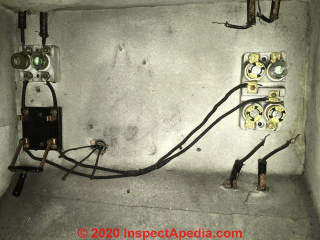 Sharon
Sharon
Thanks for the interesting asbestos-lined fuse box and for the helpful question.
That looks to me like asbestos insulating paper; If you confirm that there is no power to this antiquated fuse panel (which should be the case or made to be the case) then it should be a trivial effort to make it safe; to leave everything in place you could simply spray paint the exposed asbestos paper or fabric, then secure the cover on the box.
On 2020-09-12 by Sharon
We purchased our early 1900s house almost 20 years ago and I think I remember the owner saying this old electrical box was lined with this asbestos - it’s quite a silvery woven material which matches some of your descriptions. The box is mounted on the inside of an outside wall of an upstairs bedroom closet and I honestly forgot about it over the years but my 20-something daughter is interested in sleeping in this space.
I would appreciate knowing if you think this is asbestos; what the risk from it might be; and any tips on either sealing a bit more and leaving in place or removing (as I would prefer). I believe all the knob and tube has been turned off and bypassed. Thank you for providing such a comprehensive resource!
On 2020-09-08 by Anonymous
Thanks. The perspective is deceptive, makes them look 10x that. Thanks again.
On 2020-09-08 - by (mod) -
The page top photo shows us asbestos fabric wire looms electrical insulation. Their diameter is roughly 1/2 to 3/4 of an inch
On 2020-09-08 by John
Hi, is there any scale reference for the top of page photo (asbestos insulated cabling in theatre)? Are they large bundles or just a close up of fairly normal diameter wires?
Reader Question: is asbestos-insulated electrical wire considered friable?
2019/04/10 Matt W. said:
I have been inspecting and creating an asbestos inventory for an electrical power company (producer, transmission and distribution). during inventory I am task with marking down the friability of inspected items.
When I can only visually identify asbestos containing wiring or cable I make the assumption it is "friable", with "non-friable being the only other option to record.
Do you consider asbestos containing wire friable when you visually identify it? Under what conditions? I default to marking all asbestos wire as friable, regardless of its condition. Any insight is appreciated.
Reply: Opinion: No. if it's in good condition asbestos-fabric insulated electrical wire is not friable
Matt
Thanks for an interesting question.
In my OPINON asbestos-fabric electrical wire insulation is not considered friable if it is good condition.
My reasoning - with which I hope you'll argue or discuss this view - is that fabric type wire insulations always contain, in addition to the fabric, coatings or are impregnated by moisture and weather resistant substances - waxes, bituminous compounds, rubber, or varnish. Those wires would not readily shed asbestos material.
A clear if rather lay-term definition of "friable" asbestos is that if you squash or rub the asbestos containing material (ACM) between a finger and thumb you can pulverize at least a portion of it into a loose powder that could then be easily made airborne.
If we touch or even rub an asbestos-insulated electrical wire in that manner in my OPINION you could not produce a measurable level of airborne asbestos particles.
Therefore in my view a cost-reasonable and risk-reasonable default of most asbestos-fabric insulated electrical wires would be "not friable".
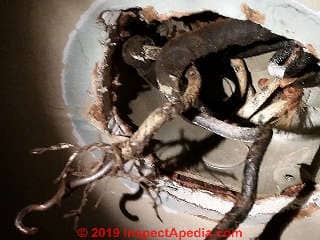
Watch out: However, if the wire is weathered, damaged, cracked, with insulation falling off or scraped off (such as by pulling old wire through openings in metal studs) THAT could (plausibly) release a detectable level of asbestos-containing fabric particles including some that may be small enough to be airborne.
Even so, an inch of frayed wire fabric end such as that shown in my light fixture wiring photo is not likely to produce a meaningful asbestos hazard in total quantity.
So in sum one needs to look at the wire type, coating, location, history, weather exposure, use, signs of overheating, and signs of mechanical damage when assessing the friability of asbestos-insulated electrical wires.
To move from my carefully-reasoned answer to a more-authoritative source, let's look at some US EPA definitions: (EPA uses the word "friable" in no less than 19 definitions.
Friable - Definition: When referring to material in a school building means that the material, when dry, may be crumbled, pulverized, or reduced to powder by hand pressure and includes previously non-friable material which becomes damaged to the extent that when dry it may be crumbled, pulverized, or reduced to powder by hand pressure.
Other examples pertinent to your question:
Air Erosion - Definition: The passage of air over friable ACBM which may result in the release of asbestos fibers.
Damaged friable miscellaneous ACM - Definition: Friable miscellaneous ACM which has deteriorated or sustained physical injury such that the internal structure (cohesion) of the material is inadequate or, if applicable, which has delaminated such that its bonds to the substrate (adhesion) are inadequate or which for any reason lacks fiber cohesion or adhesion qualities.
- U.S. EPA, VOCABULARY CATALOG Asbestos Hazard and Emergency Response Act Terms, [PDF] U.S. Environmental Protection Agency, retrieved 2019/04/10, original source: iaspub.epa.gov/ sor_internet/registry termreg/ searchandretrieve/ glossariesandkeywordlists/search.do;jsessionid= Vt5xvo4PvmrbvyaT8OhnILyF3ptZjqTtUwiUbxmj FdtRhk0nSkfg!356074923?details= &vocabName=Glossary of AHERA Terms
Let me know what you think, and post a photo or two for me (one image can be posted per comment) so that I can see the wires you are encountering.
...
Continue reading at ASBESTOS FRICTION MATERIALS or select a topic from the closely-related articles below, or see the complete ARTICLE INDEX.
Or see ASBESTOS ELECTRICAL INSULATION FAQs - questions & answers posted originally at this article.
Or see these
Recommended Articles
- AGE of a BUILDING, HOW to DETERMINE
- ANTIQUE & OLD ELECTRICAL RECEPTACLES
- ANTIQUE LAMPS (BULBS) & CONNECTOR TYPES
- ASBESTOS IDENTIFICATION IN BUILDINGS - home
- ASBESTOS in LAMPS & LIGHT BULBS
- ASBESTOS LIST of PRODUCTS
- ASBESTOS PHOTO GUIDE to MATERIALS
- ASBESTOS PRODUCTS BANNED vs PERMITTED U.S. 2023
- ASBESTOS PLASTIC ELECTRICAL PROPERTIES
- ASBESTOS in PLASTICS - p. 142-177 in Rosato
- ASBESTOS PRODUCING COMPANIES & TRUSTS
- ASBESTOS TESTING LAB LIST
- ASBESTOS TEXTILES
- FABRIC NMC WIRE INSULATION IDENTIFICATION
- OLD HOUSE ELECTRICAL SYSTEMS - home
- OLD ELECTRICAL WIRING TYPES - timeline of use of different types of electrical wire & wire insulation
- OLD HOUSE ELECTRICAL SYSTEMS
Suggested citation for this web page
ASBESTOS ELECTRICAL WIRE INSULATION at InspectApedia.com - online encyclopedia of building & environmental inspection, testing, diagnosis, repair, & problem prevention advice.
Or see this
INDEX to RELATED ARTICLES: ARTICLE INDEX to ASBESTOS HAZARDS
Or use the SEARCH BOX found below to Ask a Question or Search InspectApedia
Ask a Question or Search InspectApedia
Try the search box just below, or if you prefer, post a question or comment in the Comments box below and we will respond promptly.
Search the InspectApedia website
Note: appearance of your Comment below may be delayed: if your comment contains an image, photograph, web link, or text that looks to the software as if it might be a web link, your posting will appear after it has been approved by a moderator. Apologies for the delay.
Only one image can be added per comment but you can post as many comments, and therefore images, as you like.
You will not receive a notification when a response to your question has been posted.
Please bookmark this page to make it easy for you to check back for our response.
IF above you see "Comment Form is loading comments..." then COMMENT BOX - countable.ca / bawkbox.com IS NOT WORKING.
In any case you are welcome to send an email directly to us at InspectApedia.com at editor@inspectApedia.com
We'll reply to you directly. Please help us help you by noting, in your email, the URL of the InspectApedia page where you wanted to comment.
Citations & References
In addition to any citations in the article above, a full list is available on request.
- [1] ASBESTOS HISTORY & PROPERTIES [Book online] D.V. Roasato, engineering consultant, Newton MA, Reinhold Publishing Co., NY, 1959, Library of Congress Catalog No. 59-12535. We are in process of re-publishing this interesting text. Excerpts & adaptations are found in InspectApedia.com articles on asbestos history, production & visual identification in and on buildings.
- [2] "Asbestos in Plastic Compositions", A.B. Cummins, Modern Plastics [un-dated, pre 1952]
- [3] "Asbestos in Your Home," Spokane County Air Pollution Control Authority, Spokane WA 509-477-4727 www.scapa.org provides a one-page image, a .pdf file drawing of a house warning of some possible sources of asbestos in the home. The sources are not ranked according to actual risk of releasing hazardous levels of airborne asbestos fibers and the list is useful but incomplete.
- [4] The US EPA provides a sample list of asbestos containing products epa.gov/earth1r6/6pd/asbestos/asbmatl.htm
- Basic Information about Asbestos, US EPA, web search 08/17/2010, original source: http://www.epa.gov/asbestos/pubs/help.html
- Asbestos Strategies, Lessons Learned about Management and Use of Asbestos: Report of Findings and Recommendations on the Use and Management of Asbestos, 16 May 2003, US EPA, web search 01/20/2011, original source: http://www.epa.gov/asbestos/pubs/asbstrategiesrptgetf.pdf
prepared by the: Global Environment & Technology Foundation, 7010 Little River Turnpike, Suite. 460, Annandale VA 20003 - In addition to citations & references found in this article, see the research citations given at the end of the related articles found at our suggested
CONTINUE READING or RECOMMENDED ARTICLES.
- Carson, Dunlop & Associates Ltd., 120 Carlton Street Suite 407, Toronto ON M5A 4K2. Tel: (416) 964-9415 1-800-268-7070 Email: info@carsondunlop.com. Alan Carson is a past president of ASHI, the American Society of Home Inspectors.
Thanks to Alan Carson and Bob Dunlop, for permission for InspectAPedia to use text excerpts from The HOME REFERENCE BOOK - the Encyclopedia of Homes and to use illustrations from The ILLUSTRATED HOME .
Carson Dunlop Associates provides extensive home inspection education and report writing material. In gratitude we provide links to tsome Carson Dunlop Associates products and services.


